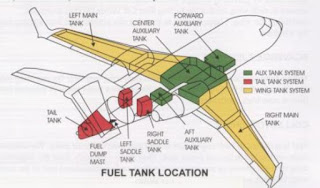Stuff I Learned - Week #3
When I was a kid, I loved to take things apart. While I harbored high hopes of fixing broken stuff, like many kids, I rarely managed to fix any of the broken stuff that I took apart. Despite my shortcomings as a fix-it person, I would often get engrossed in the hows and whys of mechanical devices. How does this thing work? Why was it built this way, and not another way? What kind of mind conceived of this thing?
My love of taking things apart (and nominally reassembling them) extended to include learning about all manner of machines. Whether it was a car, bicycle, truck, backhoe or airplane, I was hungry to learn about how things worked.
I can still remember when I first read about how airplanes worked. All airplanes needed wings, and I had previously thought of the wings as those things that kept airplanes in the air. When I read about commercial jets, though, my world was shaken in a small way - the function of the wings extended to include the storage of the fuel. The fuel tanks were in the wings!
My poor mother... I probably came upstairs from my room with all sorts of wild gyrations and gesticulations about can you believe the fuel is stored in the wings!!!! (yes, probably that many exclamation marks were used - I'm not sure how my Mother endured these periodic onslaughts of enthusiasm.)
While the fuel-in-the-wings realization may seem pretty trivial, this small step revolutionized my view of how the world works. In this small step, I came to see that function specificity is often an inefficient use of resources, and that design efficiency is often related to using one structure for multiple purposes.
OK - how does this childhood reflection relate to either Anatomy or Exercise Physiology? Well, most mechanical systems are offshoots of design paradigms that have been perfected by nature. Or put another way, virtually every muscle, bone, or tissue in the body is simultaneously serving multiple functions. For example, many of the postural muscles in the body also serve roles in respiration and the generation of
movement.
To generate movement, muscles require fuel. But this fuel can only be utilized in the presence of sufficient calcium concentrations in the muscles. Even the best meal of locally-grown, organic food cannot sufficiently fuel movement without the just-right amount of calcium present within the muscle spindles.
Like jet fuel is stored in the plane's wings, calcium reserves are stored in the bones. When the muscles require more calcium, the bones are strategically dissolved in order to release the appropriate amount of calcium. Like the fuel for the airplane is stored in its wings, one of the fuels for our movement is stored in our bones!
In a forthcoming blog, I will talk more about bone remodeling and the dynamic process of growth and decay that naturally occurs in our skeleton.
My love of taking things apart (and nominally reassembling them) extended to include learning about all manner of machines. Whether it was a car, bicycle, truck, backhoe or airplane, I was hungry to learn about how things worked.
 |
| The fuel storage of an Airbus A380 |
My poor mother... I probably came upstairs from my room with all sorts of wild gyrations and gesticulations about can you believe the fuel is stored in the wings!!!! (yes, probably that many exclamation marks were used - I'm not sure how my Mother endured these periodic onslaughts of enthusiasm.)
While the fuel-in-the-wings realization may seem pretty trivial, this small step revolutionized my view of how the world works. In this small step, I came to see that function specificity is often an inefficient use of resources, and that design efficiency is often related to using one structure for multiple purposes.
OK - how does this childhood reflection relate to either Anatomy or Exercise Physiology? Well, most mechanical systems are offshoots of design paradigms that have been perfected by nature. Or put another way, virtually every muscle, bone, or tissue in the body is simultaneously serving multiple functions. For example, many of the postural muscles in the body also serve roles in respiration and the generation of
movement.
To generate movement, muscles require fuel. But this fuel can only be utilized in the presence of sufficient calcium concentrations in the muscles. Even the best meal of locally-grown, organic food cannot sufficiently fuel movement without the just-right amount of calcium present within the muscle spindles.
Like jet fuel is stored in the plane's wings, calcium reserves are stored in the bones. When the muscles require more calcium, the bones are strategically dissolved in order to release the appropriate amount of calcium. Like the fuel for the airplane is stored in its wings, one of the fuels for our movement is stored in our bones!
In a forthcoming blog, I will talk more about bone remodeling and the dynamic process of growth and decay that naturally occurs in our skeleton.



Comments